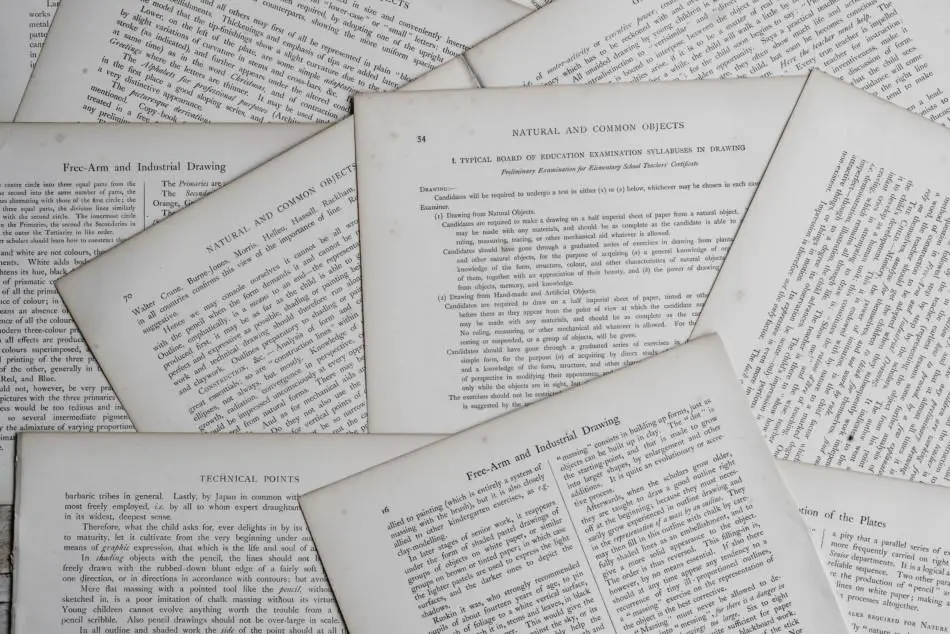Learning through a textbook is something that many of us have not had to do since finishing school. However, learning can keep the brain young and attentive and can teach you new, useful skills. But if you don’t have the time or financial comfort to go back to college, can you teach yourself a new subject through a textbook?
Learning through a textbook is possible, but you will need to implement some information retention techniques. Highlighting, jotting down the key details, and looking at the overall book structure is essential. Each student learns differently, coupling up your textbook with other methods can help.
Here you will find a detailed, step-by-step guide to teach yourself a new subject from scratch – starting today! Read on!
Understand the Two-Steps Learning Process

The chances are that when you were at school, you have used techniques like reading, highlighting, and repeating notions. Even if you have done so because that was the normal process to follow, you might have never actually learned how to learn from a textbook.
At the base of this process, there are two essential steps to take:
- The first is reading the textbook. As you could have guessed, reading the textbook is an essential part of learning what is inside.
- The second step is processing the information you have learned, repeat the key concepts out loud, or put the concept learned into practice.
This merging of assimilation and retention strategies is at the core of all the learning processes you’ll undertake if you have decided to teach yourself something through a textbook. Both phases are also essential to remember the information learned up to many years after you have first learned it.
Find the Best Learning Method for You
Not all students find that the best learning method is the one that everybody else is using. Indeed, many individuals prefer a more practical approach to make the concept theirs truly. Instead, others can retain the key points of a concept by simply reading and repeating phrases out loud.
The VARK Model and the 4 Types of Learners
According to the popular VARK model, there are four main types of learners. These are:
- Visual – learn best when the information comes from visual sources such as maps, charts, diagrams, and schemes. The connection between points should be created through arrows and circles to create a graphic representation of hierarchies. Patterns and symbols can also help a visual type to assimilate and retain more information.
- Auditory – the best method for auditory types to learn something is to listen to it and repeat it back to a teacher. Or at least, repeat the key point out loud. The best instruments to teach auditory types include lectures, discussions, emails, radio, and mobile phones. Of course, chats, web-chats, and conversations are also helpful.
- Kinesthetic – kinesthetic learners prefer hands-on activities to retain the information learned. The use of experience – whether this is real or simulated – is the best way for kinesthetic learners to retain information.
- Reading and writing – the reading and writing learners are those who can assimilate the largest amount of information through the use of channels such as Google, Wikipedia, or, indeed, textbooks.
All the types above can successfully learn through a textbook, but modifications of the base strategy might need to be implemented. In some cases, you might need to watch a video or documentary about what you have read in your book or put your notions into practice right away.
Unfortunately, there is no one-formula-fits-all, due to the extensive range of methods you can choose from when learning from a textbook.
Another factor to consider is the subject you are trying to learn. Some subjects are going to be much easier to understand just by reading a book than others. If you are trying to learn about an extremely practical subject – such as construction – you might need to put into practice each notion to absorb it truly.
Indeed, in this case, theoretical knowledge about a subject might not be enough for you to have a satisfying grasp on the subject. In any case, a textbook is an excellent starting point to learn the basics of a subject.
Start From the Table of Content or Index

Once you have picked a textbook to start exploring a new subject, it is now time to approach it and start learning. However, it is easy for many individuals to become extremely intimidated at the look of extensive time.
Knowing how to approach such a large textbook is essential for two reasons:
- It can help you get started right away without intimidation
- It can offer you an essential overview of the concept you are about to learn and supply the content and structure of your course.
That is why you might opt to look at the table of content or index first. These sections will be at the front or end of the book and can show you what the main chapters will be about. Besides starting to understand the different sections of the book, you should also look at the particular aspects that the textbook is covering.
Indeed, any subject can be explored through a multitude of approaches. Picking the right type of approach can make a difference in what you will learn by reading that particular book.
Look at the Book’s Structure
Another important aspect to notice when checking out a textbook is how the headings, subheadings, sections, and side notes are positioned. Indeed, students might take some time to understand how to read a textbook to assimilate as much information as possible.
Understanding the structure before even jumping into the sections you want to learn about can help you find out what structure to expect from the book. For example, you can become more familiar with the look and font of headings, sub-headings, and curiosity sections that might not be essential after all.
Check Out the Answers at the End
Once you are more familiar with the sections that you are about to explore in-depth, it is time to move onto the answers at the end of the book. Usually, textbooks, like those used in school, boast a useful section, just before the index.
This textbook’s section includes questions and answers, organized in the order in which they are meant to appear in the book. Head to this section and read all the questions. Even if you are not sure about most answers, try to reply somehow – even just by jotting down a piece of information that you had deemed relevant.
This will show you your current knowledge about the subject and what section you should think about spending the most time on. This is also a fun exercise and can show you that you already have a base knowledge.
As an extra tip – avoid jotting down your answers on the textbook, as you are likely to need that space for when you will need to answer those questions for real!
Have a Look at the Final Summary
Now that you have figured out about your knowledge in the subject move onto the final summary of the book. While this can seem strange at first, and you might not understand everything you are reading, there is an important reason behind this activity.
When reading a textbook, you will explore each subject and sub-section in detail, and you will get to the very core of the argument or subject. However, when studying a concept so in-depth, it is easy to lose track of the bigger picture.
And, if this happens, you might also forget why you are studying this subject in the first place! Especially if you wish to apply what you have learned in real life, details are useful, but the bigger picture is just as important.
An example of this would be a section of a book about using a nail and hammer to keep two wood panels together. While the specific section might go into details on how to perform this action, you should not forget what you are building! This allows you also to modify the rules for your convenience.
Start by reading the summary of the book to learn what the finished product of your effort will look like.
Read for Key Details
Now you have a clear idea regarding the book that looks like, and you have become more familiar with the summary. So, it is time to pinpoint the key details of the book. These will be the base concepts on which to build your knowledge and become an expert on the subject!
Since you have previously studied the structure of your textbook, you know what the key points look like. In some textbooks, especially older ones, these are likely to be bold or in italics.
Some more recent textbooks might also boast a highlighted section just below the chapter’s heading that summarizes all the key points included in the section ahead. If your book is really well-structured, you might even have such sections indicated with a “chapter’s key points” subtitle.
While you might not be able to read and remember them all after the first time you read them, you must go through them. Just like what you did with the summary, this step allows you to gain another perspective (a little deeper one) about what you are about to read in detail.
This step is also important because some sections in textbooks might not be essential. For example, if you are reading such a textbook to learn how to build a table, the chapter about the history of tables might not be the one for you! Even if these chapters can help you build on your knowledge, they might not be as immediately important as others.
Therefore, scanning the chapter’s main points can indicate what chapters are more important.
Identify a Portion or Paragraph to Learn

Now you should know what chapter you want to start with. Once you have identified it, it is time for you to start learning. This can be a two-step process that involves reading (or assimilating information) and repeating (or retaining information).
Check out the few sections below to find out how to assimilate and retain as much information as possible from the paragraph you have picked. Before jumping in the list of action, what you will need is:
- Pen
- Paper
- Highlight – ideally of different colors
Write Down the Key Points
During your first time reading the chapter, highlight the key points in each paragraph. As we have seen above, you are likely to have them all grouped together at the beginning of the chapter. However, as you read through the pages, you might find that something is even more important.
Therefore, it is essential to highlight any concept that you believe could be helpful to you in the future. As we are about to see, you should jot down what you have learned in pieces of paper next to you.
Indeed, this step seems to be useful for most learner types. Readers and writers might decide to opt for this strategy naturally. However, auditory, visual, and kinesthetic can also create a mind map in front of them.
This is an excellent way to assimilate what was in the book and twist it slightly to better fit the way we learn and remember information.
Create Question/Answer Cards
With the information that you have been jotting down, you can now create question-and-answer cards. Some individuals prefer to write the question on one side of the paper and the answer on the other, so that is hidden until the last minute.
However, another option is to use a whole white sheet of paper, write the questions at the top, and the answers at the bottom. Then you can create two piles that you can use to revise.
When writing the questions, it is important to notice that not everybody likes to use the same format or type. Since each learner might prefer a different type of question formulation, try out different styles, and opt for the one that offers you better chances of remembering the answer.
Alternatively, you can opt for a mix-and-match strategy that can allow you to simulate a real interview or exam.
Take Breaks After the First Chunk of Information
Once you have finished the first chapter and are satisfied with what you have learned today, it is the perfect time to move onto the second phase of learning – the assimilation step.
However, you should not attempt to do so before a short break. Indeed, our attention span might be much more limited than you would think, and giving our break the time to assimilate the load of information can only be beneficial.
Have a snack and short break, then move onto the retention phase. Depending on what is your best way of learning, you could opt to revise or repeat the section learned out loud. If you are studying with somebody else next to you, you might repeat it to them.
In some cases, students prefer to use the information to create mind maps and turn what they have learned into a scheme or diagram for better assimilation. Once you have rested, go over what you have learned one last time before closing up your session for the day.
Below you can find some more tips to use to increase the chances of retention.
Use the Cards to Quiz Yourself
Since you have been preparing the cards with all the essential information you have gathered from the chapter, you also should have the juice of what you have learned.
If you don’t have the time to repeat the whole chapter out loud, use such cards to quiz yourself on the most important notions contained in that chapter. This might not take long, but it can help you retain at least the very core of what you have absorbed in the last chapter.
If you have written the most important points as both a statement and a question, you can also revise such points. While at first might not seem enough information to feel like having learned a new subject, this step is essential.
Especially as you have just approached a new subject, you should not overload your brain with details that won’t leave enough room for the essential notions you need to assimilate.
Using the method highlighted above allows you to become familiar with the main points of the chapter and remember them for later. These are also crucial roots of a subject that you have to cultivate before adding smaller details – or branches – to your knowledge.
Periodically Go Through All of Your Questions
Once you have finished a chapter and asked yourself the question you had written down, the main part of the job might seem over. However, you still have a little more work to do! When you dedicate yourself to this step depends on what you have decided to teach yourself for.
If you are studying for a school exam or accessing a course, you might decide to go through all the past questions and answers repeatedly in the days before your exam. Instead, if you have already been putting in more practical knowledge, you might only need to revise your questions if there is something you have forgotten over time.
However, in both cases, you should keep your card for you to use in a moment of need – especially when you don’t have the time to search the information in the textbook again!
Put What You Have Learned Into Practice
Especially if you belong to the group of learners defined as kinesthetics, you will need to put the notions learned into practice as soon as possible to make it yours truly. You can do this whether or not what you have learned is practical or not.
If you have studied a mathematical or philosophical concept, you might not be able to test in the field immediately. However, you can make it appear more real by drawing it or creating a diagram. If you have the chance to apply the method to learn math or physics’ problems, this is the time!
Alternatively, if you have just finished studying a very practical topic because you needed to build or fix something, you should get to work right away! While you might not be able to finish your project today, this is an excellent starting point to build your knowledge.
Use Other Methods
Not everybody who learns the same textbook is comfortable using the same methods for learning. Especially among young adults belonging to Generation Z and Generation Alpha, these types of media learning methods have already become more popular.
Alternating standard learning methods such as textbooks to more practical and interactive channels can be extremely beneficial. For example, you can use apps such as DuoLingo to test the knowledge of a language you have started to learn in your textbook.
Alternatively, using YouTube videos can point you in the right direction when it comes down to applying step-by-step guides. Lastly, platforms such as Udemy, MasterClass, and Skillshare are excellent ways of finding an interactive method to deepen and try the skills you have just learned.
Learning how to read faster, with less effort, and more effectively (effective reading) can also help you assimilate information faster. You can check out some tips for this in the video below:
Extra Tips for Learning With a Textbook
Below you can find extra tips that can make it easier to learn from a textbook.
Understand That Details Matter – For the Bigger Picture!
Learning and reading are among the most beneficial and exciting activities you can decide to undertake. Learning is extremely important for the brain and can keep it active, younger, and responsive.
However, when you are learning something, you are storing an impressive amount of information in the brain. This information has to be moved into the long-term memory section from the short memory storage before you can comfortably add new items to your knowledge.
When learning a new subject, topic, or detail for the first time, you are likely to have only a limited amount of information.
Therefore, everything you are learning is new. If you start remembering all the superficial details of a topic, your brain will store it, limiting the amount of space remaining for the crucial pieces of information.
Instead, filtering out all the details for a later moment can be an optimal strategy to learn a few key points each time – the ones at the base of a concept!
Find a Buddy
Studying and revising with a buddy is obviously much more fun. However, you might also need a buddy if you are of the auditory type of learners.
Indeed, if you need to revise and repeat what you have learned to the ones around you, you will need someone that can ask you questions and correct your answers.
Ultimately, a buddy can also help you gain a better grasp of concepts you were not comfortable with.
Adapt the Method Above to Your Own Taste
In the sections above, we have had a look at the most common and effective technique to learn from a textbook. However, we have also noticed how there are different types of learners.
Therefore, while your buddy might feel completely comfortable with this technique, you might need to adapt it to your taste. You can do so by switching to a different way of remembering the facts or introducing a parallel learning method such as discussions or videos.
Pros and Cons of Teaching Yourself With a Textbook
Here is a brief overview of the pros and cons of learning from a textbook.
Pros
- Self-paced learning method
- Inexpensive and accessible by most individuals
- Nothing is required aside from pen, paper, and the textbook.
- You can find a completely-digital version of this learning method by switching to using an eBook and computer instead.
- Perfect to fit in any lifestyle
- No need to go back to college to learn something new
- You won’t face any charge for schools or lessons.
- There is no commute!
- Allow you to keep learning.
- You will be able to move onto the next level of learning at any point.
Cons
- Lack of certification
- Managing your time can be tricky – this is one of the main reasons many self-taught students fail or give up.
- This method is best for theoretical subjects but can be adapted through the implementation of other media sources.
- When it comes down to practice what you have learned, you might struggle to find an area where you can exercise your skills. Instead, if you study in a university or lab, you would have all the necessary facilities.
Conclusion
Teaching yourself with a textbook is entirely possible and enjoyable. This self-learning method is perfect for those who want to learn a more theory-based topic at their own pace. While it does not help you achieve a qualification directly, you could learn for many reasons, either personally or for career-related reasons.
When learning through a textbook, you should know that there are two phases you will encounter: the assimilation and retention. While some learners are happy to just use the textbook for these two steps, you could also decide to implement other methods such as videos.
Sources
- The National Academies of Sciences, Engineering, and medicine: Learning and Transfer
- University of Kansas: 4 Different Learning Styles You Should Know: The VARK Model
- Western Michigan University: Textbook reading strategies
- BUCKS: The Basics of Effective Learning
- Columbia College: Highlighting and marking
- Online Schools.org: The Science of Taking a Break
- Oregon State University: Memory: It’s a Process






